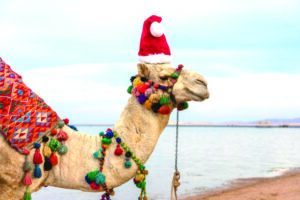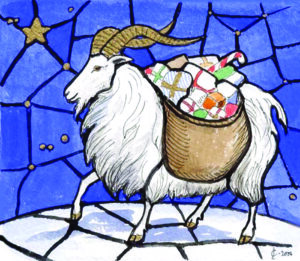By Dr. Beth Leermakers
Six white boomers,
snow white boomers,
Racing Santa Claus through the blazing sun.
Six white boomers,
snow white boomers,
On his Australian run.
In Australia, where it’s too hot for Rudolph and his fellow reindeer, male kangaroos (boomers) pull Santa’s sleigh. Australians sing about six white boomers who, after delivering all the toys, help a young joey find his mother. Kangaroos hop at about 15 miles per hour but can reach speeds of more than 35 mph. They cover 25 feet in a single leap and can jump six feet high. All that fast hopping makes for a bouncy ride for Santa, who has to fasten his seatbelt and hang on for dear life.
In celebration of Christmas, let’s take a look at a few other animals that are associated with Christmas throughout the world.
Camels. Said to have carried the Three Wise Men, or Magi, to Bethlehem, camels often feature prominently in nativity scenes. Camels are perhaps best known for their ability to travel great distances without drinking water. When they find water, they can drink 40 gallons. They don’t store water in their humps, which are actually used to store fat. Stored fat provides nutrition and energy for weeks or even months when food is scarce.

Photo courtesy of Pinterest
Camels store water in their blood. Camels’ red blood cells can expand up to 240 percent of their regular size with water when camels rehydrate. This allows camels to drink up to 30 gallons in 10 minutes. Other animals’ blood cells would burst if they drank so much, so quickly.
Partridges. Partridges nest on the ground, not in pear trees as the carol (“The 12 Days of Christmas”) suggests. They belong to the family Phasianidae, which includes pheasants, chickens, turkeys and other gamebirds. Grey partridges, which look like chickens, live together in coveys (groups of 20 or more birds). Females lay 10-20 eggs per nest, and the eggs take three to four weeks to hatch. Partridges can’t fly very well, so they don’t migrate; many spend their whole lives in the same three or four fields.
Grey partridges are omnivorous, and their diet changes as they age. During the first three weeks, the cheepeer (baby) needs large amounts of protein for bone and muscle development. During this stage, more than half of partridges’ diet consists of small insects such as crickets and beetles. After three weeks, they become primarily vegetarian, with 95 percent of their diet made up of fruits, leaves, roots and flowers.
Robins. Robins often appear in snowy Christmas card scenes. Victorian postmen were nicknamed “robin” because of their bright red jackets. The colorful birds were shown on Christmas cards carrying cards in their beaks — representing the mailmen who would be delivering cards and holiday greetings. Robins have about 2900 feathers. Unlike pheasants, robins are terrific flyers, traveling at 17 to 32 mph. At those airspeeds, they’ll quickly deliver all the Christmas cards in their mail bag.
Yule goats. In Sweden and other Scandinavian countries, straw Yule Goats are common Christmas decorations. Yule goat ornaments are placed under the Christmas tree, and Swedish towns and cities build large statues. The Yule Goat dates back to ancient pagan festivals. The Norse god Thor rode in the sky in a chariot drawn by two goats. Notice the similarity to Santa?

Photos courtesy of Ancient Pages
Swedes believed the Yule goat was an invisible spirit that appeared before Christmas to make sure the holiday preparations were done correctly. The goat eventually took on the role of gift giver and sometimes appears instead of or alongside Santa.
A popular Christmas prank was to place a straw or wooden Yule goat in a neighbor’s house without them noticing. The family that received the goat had to place it in another family’s home. Perhaps this is the origin of Elf on the Shelf?
Whether your cards and gifts are delivered by reindeer, kangaroos, robins, goats or Amazon drivers, I hope Santa rewards you for being good this year.
Merry Christmas!
